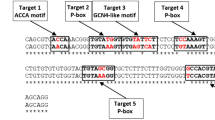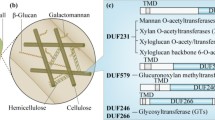Abstract
The regulatory properties of maize phosphoenolpyruvate carboxylase were significantly altered by site-directed mutagenesis of residues 226 through 232. This conserved sequence element, RTDEIRR, is part of a surface loop at the dimer interface. Mutation of individual residues in this sequence caused various kinetic changes, including desensitization of the enzyme to key allosteric effectors or alteration of the K0.5 PEP for the substrate phosphoenolpyruvate. R231A, and especially R232Q, displayed decreased apparent affinity for the activator glucose-6-phosphate. Apparent affinity for the activator glycine was reduced in D228N and R232Q, while the maximum activation caused by glycine was greatly reduced in R226Q and E229A. R226Q and E229A also showed significantly lower sensitivity to the inhibitors malate and aspartate. E229A exhibited a low K0.5 PEP, while the K0.5 PEP of R232Q was significantly higher than that of wild type. Thus these seven residues are critical determinants of the enzyme’s kinetic responses to activators, inhibitors and substrate. The present results support an earlier suggestion that Arg 231 contributes to the binding site of the allosteric activator glucose-6-phosphate, and are consistent with other proposals that the substrate phosphoenolpyruvate allosterically activates the enzyme by binding at or near the glucose-6-phosphate site. The results also suggest that the glycine binding site may be contiguous with the glucose-6-phosphate binding site. Glu 229, which extends from this interface region through the interior of the protein and emerges near the aspartate binding site, may provide a physical link for propagating conformational changes between the allosteric activator and inhibitor binding regions.
Similar content being viewed by others
Abbreviations
- CAM:
-
Crassulacean Acid Metabolism
- G6P:
-
glucose-6-phosphate
- PEP:
-
phosphoenolpyruvate
References
Bandarian V, Poehner WJ, Grover SD, (1992). Metabolite activation of Crassulacean acid metabolism and C4 phosphoenolpyruvate carboxylase Plant Physiol 100: 1411–1416
Chollet R, Vidal J, O’Leary MH, (1996). Phosphoenolpyruvate carboxylase: a ubiquitous, highly regulated enzyme in plants Ann Rev Plant Physiol 47: 273–298
Engelmann S, Blasing OE, Westhoff P, Svensson P, (2002) Serine 774 and amino acids 296 to 437 comprise the major C4 determinants of the C4 phosphoenolpyruvate carboxylase of Flaveria trinervia FEBS Lett 524: 11–14
Gao Y, Woo KC, (1996). Regulation of phosphoenolpyruvate carboxylase in Zea mays by protein phosphorylation and metabolites and their roles in photosynthesis Aust J Plant Physiol 23: 25–32
Gillinta J, Grover S, (1995) Kinetic interactions of glycine with substrates and effectors of phosphoenolpyruvate carboxylase from maize leaves Photosynth Res 45: 121–126
Gonzalez D, Iglesias A, Andreo C, (1984) On the regulation of phosphoenolpyruvate carboxylase activity from maize leaves by l-malate. Effect of pH J Plant Physiol 116: 425–434
Izui K, Matsumura H, Furumoto T, Kai Y, (2004) Phosphoenolpyruvate carboxylase: a new era of structural biology Annu Rev Plant Biol 55: 69–84
Kai Y, Matsumura H, Izui K, (2003) Phosphoenolpyruvate carboxylase: three-dimensional structure and molecular mechanisms Arch Biochem Biophys 414: 170–179
Matsumura H, Xie Y, Shirakata S, Inoue T, Yoshinaga T, Ueno Y, Izui K, Kai Y, (2002) Crystal structures of C4 form maize and quaternary complex of E. coli phosphoenolpyruvate carboxylases Structure 10: 1721–1730
McAlister L, Evans E, Smith TE, (1981) Properties of a mutant Escherichia coli phosphoenolpyruvate carboxylase deficient in coregulation by intermediary metabolites J Bacteriol 146: 200–208
Meyer CR, Rustin P, Wedding RT, (1988) A simple and accurate spectrophotometric assay for phosphoenolpyruvate carboxylase activity Plant Physiol 86: 325–328
Rajagopalan AV, Devi MT, Raghavendra AS, (1994) Molecular biology of C4 phosphoenolpyruvate carboxylase: structure, regulation and genetic engineering Photosynth Res 39: 115–135
Rickers J, Cushman JC, Mickalowski CB, Schmitt JM, Bohnert HJ, (1989) Expression of the CAM-form of phospho(enol)pyruvate carboxylase and nucleotide sequence of a full length cDNA from Mesembryanthemum crystallinum Mol Gen Genet 215: 447–454
Rodriguez-Sotres R, Munoz-Clares RA, (1990) Kinetic evidence of the existence of a regulatory phosphoenolpyruvate binding site in maize leaf phosphoenolpyruvate carboxylase Arch Biochem Biophys 276: 180–90
Rustin P, Meyer CR, Wedding RT, (1988) Identification of substrate and effector binding sites of phosphoenolpyruvate carboxylase from Crassula argentea. A possible role of phosphoenolpyruvate as substrate and activator J Biol Chem 263: 17611–17614
Rustin P, Meyer C, Wedding RT, (1991) Fluorescence study of chemical modification of phosphoenolpyruvate carboxylase from Crassula argentea Plant Physiol 97: 1011–1016
Sayegh J, Y. J, Sward L and Grover S (2002) Identification of arginine residues involved in activation of maize PEP carboxylase. Presented at Exp. Biology 2002, New Orleans 427.4
Sutton F, Butler E, Smith T, (1986) Isolation of the structural gene encoding a mutant form of Escherichia coli phosphoenolpyruvate carboxylase deficient in regulation by fructose 1,6-bisphosphate. Identification of an amino acid substitution in the mutant J Biol Chem 261: 16078–16081
Terada A, Kotera M, Tsumura K, Furumoto T, Matsumura H, Kai Y and Izui K (2001) Phosphoenolpyruvate carboxylase (PEPC): mutational analysis of a flexible loop and a putative binding site for an allosteric activator, glucose 6-phosphate (G6P). Presented at the 12th Interntl. Congr. Photosyn., Brisbane: S17-029
Toh H, Kawamura T, Izui K, (1994) Molecular evolution of phosphoenolpyruvate carboxylase Plant Cell Environ 17: 31–43
Tovar-Mendez A, Mujica-Jimenez C, Munoz-Clares R, (2000). Physiological implications of the kinetics of maize leaf phosphoenolpyruvate carboxylase Plant Physiol 123: 149–160
Tovar-Mendez A, Rodriguez-Sotres R, Lopez-Valentin D, Munoz-Clares RA, (1998) Re-examination of the roles of PEP and Mg2+ in the reaction catalysed by the phosphorylated and non-phosphorylated forms of phosphoenolpyruvate carboxylase from leaves of Zea mays. Effects of the activators glucose 6-phosphate and glycine Biochem J 332: 633–632
Acknowledgements
This work was supported by NIH MBRS-RISE grant GM61331 and NIH Biomed-PREP grant GM 64104. The authors would like to thank Prof Vahe Bandarian for his assistance with this project.
Author information
Authors and Affiliations
Corresponding author
Rights and permissions
About this article
Cite this article
Yuan, J., Sayegh, J., Mendez, J. et al. The regulatory role of residues 226–232 in phosphoenolpyruvate carboxylase from maize. Photosynth Res 88, 73–81 (2006). https://doi.org/10.1007/s11120-005-9032-x
Received:
Accepted:
Published:
Issue Date:
DOI: https://doi.org/10.1007/s11120-005-9032-x




